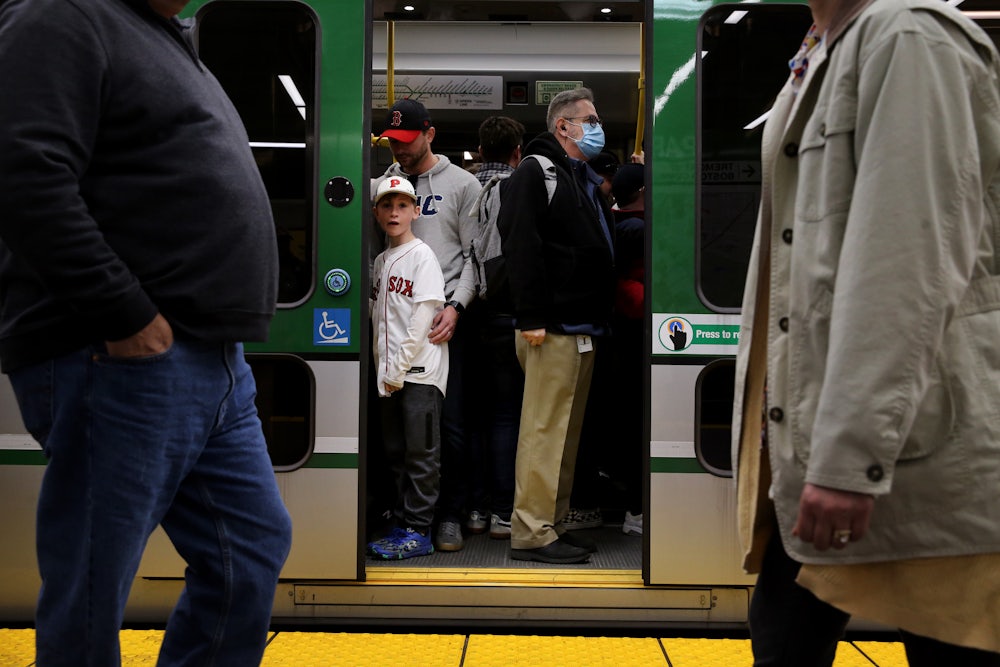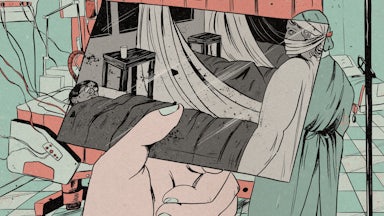Almost since the beginning of the Covid-19 pandemic, epidemiologists, policymakers, science journalists, and many more have held onto two general assumptions that give them hope: that eventually enough people might develop immunity to Covid-19 to slow down transmission and that even if Covid doesn’t fade away, it might become a more seasonal illness, like respiratory viruses such as the flu, RSV, and other bugs—even other coronaviruses. But now, as cases rise steeply and summer approaches, Covid is again taking us by surprise.
There were some early signs that Covid might be different: While previous waves have reached their greatest peaks in winter, the virus also did significant damage in other seasons. And now, with the omicron wave, even more evidence is accumulating. While we’ve had two relatively calmer summers with regional spread, the relaxation of measures across the country seems to have triggered another surge, with nearly every state seeing an increase in Covid cases and hospitalizations.
“The wild card is the rise of variants,” Marc Lipsitch, professor of epidemiology at Harvard’s T.H. Chan School of Public Health, told me over a year ago, when I asked him to predict what Covid would look like in 2022. How fast the virus would evolve would determine much about the next few years. Since then, variants have arisen that can evade our immune protections with startling efficiency. Even those who already suffered from cases of the first omicron variant in January or February are now reporting new cases of BA.2 or BA.2.12.1, two omicron subvariants in the United States that have quickly risen to dominance. While back in November 2020, one study suggested people who contracted Covid-19 and recovered might be immune to reinfection for years or even decades, it’s now clear that won’t be the case because of rapidly changing variants. People who recover from Covid-19 now can be reinfected in a matter of months.
With a virus that spreads year-round, is capable of reinfection, and is still evolving rapidly, and with few public protections still in place, we could be facing a future where we all get sick several times a year. Covid may stay with us for the foreseeable future, not as a seasonal threat but as a regular companion.
A future where people get Covid several times per year could have major implications for the immune-compromised and anyone seeking health care in a perennially stretched system. And it will ripple through schools and workplaces strained by illness. “It’s very disruptive to the functioning of society to have repeat surges and repeat infections with new variants every few months,” Abraar Karan, an infectious disease specialist at Stanford University, told me. Resurgences are “very, very disruptive—you’re still sick enough to be out of work, to have to be at home.”
Even before the pandemic, parents struggled to care for kids unexpectedly home from daycare and school with a seemingly endless array of viruses. People who didn’t have paid leave had to take unpaid time off from work, if they could, or work while they or loved ones were sick. Adding another virus to the mix, permanently and without any real off-season, could interrupt education and wreak professional and economic havoc.
Even once quarantine and isolation requirements are lifted, sick people will still need to stay home to recover, and parents will have to care for sick children. While omicron has been hailed as “milder”—a complicated concept already—a new preprint study that has not been peer reviewed or published indicates that omicron is just as severe as previous variants, including delta. Meanwhile, immunity from vaccines and prior infection is waning.
Medical care could also become infinitely more complicated. What happens for those seeking any type of care during a surge, when health systems are once again overwhelmed? What of patients with new diagnoses, new cancer treatments, new transplants—how will they navigate a system that, thanks to the desire of millions to get “back to normal,” is increasingly hostile to medically vulnerable people? This is an especially pressing question as millions of Americans are now grappling with long Covid.
Right now, two and a half years into the pandemic, there are still many questions without answers. How will we navigate a world with so much Covid spreading, if this is something like our steady state? What will multiple infections do to our bodies, our organs, our lives? And if this isn’t the future we want, what do we need to do to stop it? “That’s, of course, the question that everybody’s asking right now,” said Daniela Weiskopf, a research assistant professor at the La Jolla Institute for Immunology.
Adapting to constant Covid risk won’t be easy. “We have a strategy for flu,” Karan said, noting that influenza is more seasonal and less transmissible. Updated vaccines for the flu roll out right before it’s expected to rise each winter, helping to suppress severe illness and death. But with Covid, there’s no such strategy. “With Covid, we’re seeing something different, which is very fast mutations, large resurgences with new variants.”
And it’s not just its relative lack of seasonality that sets Covid apart—it also damages organs in ways we usually don’t see with respiratory viruses. There’s evidence that Covid affects the heart, lungs, brain, liver, and kidneys, possibly for years or even a lifetime. “We don’t know what the long-term effects are,” Karan said. And it is unclear now what repeat infection will do to our bodies. The recent shift to focusing on hospitalizations and deaths instead of cases could do a major disservice to those whose mild cases have long-term consequences, he said. “Given that we don’t know that, our policymakers and public health leaders should not be discounting the importance of cases.”
The crystal ball is still cloudy on Covid’s future, even after years of learning about it. “We don’t know what the next variants are going to do. They could be more virulent. They could be more transmissible. They could be both,” Karan said. “We’re dealing with a lot of unknowns, and what we do know is that we are very vulnerable to having major disruption at minimum and potentially more hospitalizations and deaths, at worst, in the future.”
Even once we reach a steady state where Covid cases are more predictable, that doesn’t mean the virus won’t have severe implications. HIV is endemic. Malaria is endemic. Tuberculosis is endemic. Those illnesses are still deadly—in fact, in some case, they’re growing deadlier as they evolve to survive.
“As long as we allow uncontrolled spread, every time the virus infects somebody, it has a chance to mutate,” Weiskopf said. “There is a possibility that new variants come up, and we do not know if they are milder or more severe.”
Every time Covid reveals a new surprise—that it spreads through the air, or it’s evolving more than expected, or emerging with surprising characteristics from unexpected sources—experts always come back to the same conclusion. At any point, we could choose to curtail this virus sharply, cutting off future mutations and tamping down the general uncertainty of the pandemic, or we could choose to continue believing that eventually it will just go away. We could use what we’ve learned to prevent future heartache, or we could allow the virus to keep leading the way—with plenty of middle ground in between.
The fact that we now are where we are—that Covid doesn’t seem to be weakening as people had hoped and seems to be getting better at evading vaccine protection—has a lot to do with policymakers deliberately choosing the low-investment path. But it still doesn’t have to happen this way. Our knowledge of how to prevent respiratory infections has grown exponentially; we have flattened cases of the flu and RSV to an astounding extent during previous rounds of the pandemic.
One of the most dangerous traps of understanding and responding to infectious disease is falling into binary thinking: Precautions are 100 percent effective, or they’re useless; Covid is over, or it’s everywhere.
“Even if we don’t eliminate Covid, we can still mitigate transmission,” Karan said. “We could do a lot better.” Tried-and-true prevention includes high-quality masks, ventilation, widespread and affordable testing and treatment, paid sick leave, and other support for caregivers and those who fall ill. “Those things matter,” Karan said. But “we have not been doing those. In fact, we’ve just abandoned a lot of that now.”
It is difficult to control disease only through individual behavior, and it’s hard to maintain, especially in the long term. Tools like condoms to prevent HIV or bed nets to prevent malaria can be extremely helpful for individuals navigating a risky environment, but systemic changes can matter even more. For Covid, that means strategies like updating vaccines, developing highly effective treatments, and improving ventilation in indoor spaces. “What if we increased air changes per hour in all public areas, with input from ventilation experts—could that significantly reduce the chance of airborne spread? That’s a really important question that the administration should really be focusing on,” Karan said.
And vaccines still matter. Although existing vaccines no longer offer the protection they once did, given new variants, they still help prevent severe illness in many people, particularly among those who receive boosters. “None of these variants we have seen so far has been able to completely evade our immune system,” Weiskopf said. While existing variants can evade antibodies, “all of them are recognized by our T-cells—the second line of our immune system,” she said. That’s what keeps an infection from progressing to severe illness. And the genes defining our T-cell response are the most diverse in all of the genes that the human body has, Weiskopf said—which means vaccines, even when they don’t prevent infection, will continue to help keep many of us safe.
Next-generation vaccines, like those inducing mucosal immunity, could stop infections in their tracks, which is why continuing to invest in our national Covid response is key. In the meantime, Weiskopf is researching how often we need boosters. “What we don’t know still today [is] what is the level of antibodies that we need—how high does the wall need to be, to make sure that people are protected from severe disease?” she said. Do you reach a plateau after, say, three shots, or do you need an annual immune reminder? Weiskopf puts it this way: “How long is your body able to keep the memory?”
Her words echoed in my ears. As I began work on this piece, the number of known U.S. Covid deaths officially passed one million. If 100,000 Covid deaths were an “incalculable loss,” what is 10 times greater than incalculable? Yet the memorials organized by local authorities or published by mainstream newspapers dropped quietly into a country where almost no mandates for precautions remain in place. Nationally, we have largely succumbed to the urge to move beyond the pandemic, even as it rages around us, a strategy that cannot continue forever.
How long will we keep the memory? The memory of everything and everyone we’ve lost, the memory of what worked to keep us safe and could still help us in the future, if only we remember what’s at stake. If we cannot or will not remember, the virus will continue reminding us every few months.










